
Candida Martinelli's Italophile Site

Main
Page This family-friendly site celebrates Italian culture for the enjoyment of children and
adults. Site-Overview
Ironically, today the work of the illuminati can be seen by
more people than ever before. The texts they illuminated, are no
longer in the hands of popes, princes, and wealthy merchants.
Today, their work is displayed in museums, with usually one
paged turned each day to reward the frequent visitor with a look at
all the splendid artistry. Luckily for us, many museums have photographed the pages and put
them on-line, so the Internet visitor can view many
pages at one go! I provide images on this page when copyright
restrictions allow, and link to the museum sites where you can view
lots more images. A full list of links is at the bottom of this
page. Browse at your
leisure. This image is an illuminated page from 1487
from the WebGallery of Art. This is the best link where you can
view illustrated manuscript pages from 1150 to 1550 from many
countries. I'll eliminate my use of words like 'stunning', 'amazing',
'gorgeous', 'mini-masterpiece' and so forth on this page, but just
assume I mean that for every example I offer up to you, because it's
what I think! Appreciate that the they must have used magnifying
glasses to help paint them and to enjoy them, because some are truly
miniscule. This example is from 1400s Northern Italy of Cicero's
writings now at the British Museum. The labor intensive steps were
usually these: This example of a tooled leather book cover is of a 1470
Venetian Bible now at the Bodleian Library. Scriptoria
made way for wood carvers who carved text and crude images in reverse
into a flat piece of wood: woodcuts. The wood was
then rolled with ink and stamped onto a page. The pages were
then assembled as described above, and the hand painting was done as
before. Only when color printing and the printing of drawings
advanced, did the illuminati find their work dwindle to the
rare contract with a rich merchant for a customized family book, or
with the church for a special text. Some illuminati found
work decorating documents like: Even today, you can hire a calligrapher do this kind of
work. They are the inheritors of this ancient art form. The earliest examples of illuminated texts are: Historiated initial D from an Italian
Book of Hours from 1450 now in the Pierpont Morgan Library,
this is my favorite link because they let you 'page through' 15 pages
of this book, I enjoy especially the accurate paintings of the flowers
and plants, and the calligraphy, and because books are generally
closed, the colors are not damaged by sunlight so they are as vibrant
today as when they were first painted (The U.S. Library of Congress has an entire French Book
of Hours from 1524 available for page by page viewing. It is
text machine printed on parchment with some pages illuminated with the
life of Mary.) One book that was a best-seller was one for a very special
reason: it was an early reader. Aesop's Fables was
used throughout Italy as a book to teach people how to read .
The Greek fables were almost always illustrated with woodcuts to help
the new-reader figure out the texts. Generally speaking, the main decorative elements are (many
illustrated below in a 1458
Florence Prayer Book that belonged to Lorenzo de Medici as seen in
the WebGallery of Art): 1458
Florence Prayer Book that belonged to Lorenzo de Medici as seen in
the WebGallery of Art
Here are some of the
miniatures from a rare manuscript of Marco Polo's Travels from 1400, now
at the Bodleian Library and available to
view on-line (from page/folio 218-271). The artwork is by a Johannes and his school of artists. This painting supposedly shows the Polos leaving Venice to return to
the east, with Marco in tow. Look to the right, next to the giant
swans, and you can see Marco (in red) with his father and uncle, about
to board a very small boat. Venice, as painted by Flemish artists who knew only certain things
about the city, tends to look a lot like Brugges. The add the
famous 4 horses in what is supposed to be St. Mark's Cathedral
(left-top), and the arches on the ground floor of the Doges Palace, with
what looks like the Doge and his wife on the balcony, watching the Polos
leave.
Here the Polos receive a golden passport from the Khan. It's
amazing to see the background and floor paintings in this miniature
artwork, as well as the frame decorated with stars. And the
flowers around the image are filled with metallic ink. After the
next image, I include an image of an entire page, so you can see just
how small these miniature paintings really are. Mind-boggling.
Here Marco and his uncles are giving the Khan the oil from Jerusalem
and the messages from the Pope. Again, the background, floor and
frame are stunning in detail, as are the robes of the Khan and
courtiers. Much of the detail was certainly painted with
single-haired brushes. I include an image of the whole page, so
you can see just how small the images really are. It is curious to see that they had no idea what a Khan (or Caan as they call
him in the French, it was written Kaan in the English translations)
would look like. They guessed a scrawny guy with a wispy beard.
They got the beard part so-so, but the Khan was certainly not scrawny,
judging from the images we have of him, but stocky with a round head.
The red texts are Marco Polo's chapter headings. The black texts
are the chapter contents. This manuscript is in French. This Adoration of the Magi depicts the scene described by Marco Polo,
as told to him by people in Persia, about the Three Kings visiting Mary,
Jesus and Joseph. Joseph is my favorite here, shunted off in the
far right, on a hard stool, left out of the whole gift-giving thing.
Mary has a crown and regal robes. All Joseph has is a plain robe.
I don't know who, but the three open boxes fascinate me. I want
one of those boxes. The backgrounds are jewel-like.
The Khan goes hunting with his falcons, dogs and staff. His
palace has a decided medieval look to it. I've included in this
image the following capital letter, illuminated with a Mongol soldier
inside the 'Q', armed with shield and sword, and a dragon spewing out
the letter.
This is my favorite miniature, not just because the Khan is getting
dressed in European armor (not Mongol war armor, and not just because he
has Renaissance tents rather than Mongol tents as he prepares for
battle. This is my favorite painting because of the Flemish artists'
depiction of a Mongol war elephant. They clearing have no idea of
the size of elephants, and only know that the animal has big ears and a
long snout. So here we have a cow with big ears and a long snout,
smaller than the horses.
Here the Khan receives tributes from representatives from all his
conquered lands. The detail is, again, a thing of wonder.
I've included the following capital letter so you can see another Mongol
warrior with weapon and shield, and the creature that makes up part of
the letter. Some of the dots are applied with the head of a
needle.
This is the banquet scene as described by Marco Polo. The Khan is
at the head table alone, only surrounded by Barons who served him his
food and drink. The Khan's wives are seated at a lower table to
his right. All the service is of gold. Marco also describes
a drink dispenser that other later visitors to Mongols-Tartars describe
too, the fountain filled with drink.
The artist put the musicians that Marco described at these events, in
the border. The musicians played every time the Khan drank, so
that everyone else would stop and pay tribute to the Khan throughout the
meal (the kneeling men).
Here the Great Khan is going hunting with his dogs. At the right
are the wild animals, a deer, boar and a funny-looking bear. I
personally prefer Dino the dinosaur on the capital letter that follows.
Here the Khan's barons are helping him keep his accounts.
Here the Mongols are fighting with an enemy, using catapults and
cannons.
This lovely image depicts Marco and his father and uncle in India,
where pearl-divers collect the jewels from the oysters below the water.
One hands the jewels to the uncle, while another is still below the
water collecting jewels.
Some Amazon.com books on this subject:
Some interesting links: Illuminated stationary
and bookmarks for sale on-line The Medieval Scribe will
illuminate your wedding invitations for you, make illuminated scrolls
and certificates Bodleian
Library Manuscripts On-Line by country and century The Illuminated Middle
Ages, Illuminated Manuscripts from French Libraries Masterpieces
in Miniature, The Getty exhibit Catalog of Illuminated
Manuscripts at the British Museum search-page, enter 'Italy' '1200'
to '1500' to see their on-line collection (I did the search and got this,
but you may have to do it again) The Vatican
Museum's collection of illuminated manuscripts with some images
online, the famous Urbino Bible is in their collection WebGallery of Art Illuminated
Manuscripts from Italy 1450-1500 has stunning images not
copyrighted, free to use and enjoy (tip: they make beautiful and
unique Christmas Cards printed out on a color printer)
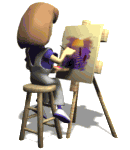
 lluminated
Texts - Masterpieces by Illuminists
lluminated
Texts - Masterpieces by Illuminists![]()
![]()
Introduction - Illuminati
![]() Illuminati
is where the English word 'luminaries' comes
from. Illuminati, the illustrious luminaries of their
time, were the artists who decorated texts in Medieval
and Renaissance Italy. During their day, these painters
Illuminati
is where the English word 'luminaries' comes
from. Illuminati, the illustrious luminaries of their
time, were the artists who decorated texts in Medieval
and Renaissance Italy. During their day, these painters  were
just as famous as the artists who painted on gesso on wood, and on
soft plaster on walls. But today, only artists such as
Michelangelo and DaVinci are household names.
were
just as famous as the artists who painted on gesso on wood, and on
soft plaster on walls. But today, only artists such as
Michelangelo and DaVinci are household names.![]()
Brief History
![]() These
artists worked from roughly the year 1200 to the 1500s.
This corresponds, not coincidentally, with the advent of primitive
book-making techniques through to advanced book-printing
techniques. The earliest technique was the hand-lettered book.
These
artists worked from roughly the year 1200 to the 1500s.
This corresponds, not coincidentally, with the advent of primitive
book-making techniques through to advanced book-printing
techniques. The earliest technique was the hand-lettered book.
 A Cutter would fold the paper into the page size
desired and cut the edges
A Cutter would fold the paper into the page size
desired and cut the edges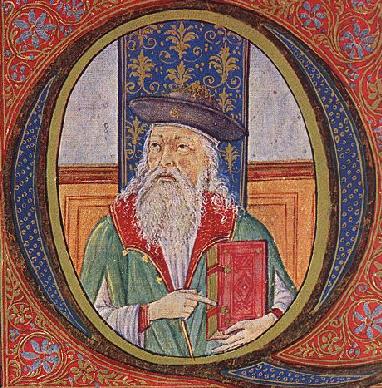 When fixed and moveable type was invented, the text was
assembled into a frame, rolled with ink, and pressed onto the
paper. The binding and decoration was then done by hand.
But even at this point in time, woodcut images were still stamped onto
pages after the text printing.
When fixed and moveable type was invented, the text was
assembled into a frame, rolled with ink, and pressed onto the
paper. The binding and decoration was then done by hand.
But even at this point in time, woodcut images were still stamped onto
pages after the text printing.
![]()
Eras and Books
![]() The Middle
Ages is considered by connoisseurs as the high-point of
illuminative arts perhaps because it is a time when both the text and
artwork were done by hand, and these texts are the major source of
Middle Age paintings. During the Renaissance, Italian illuminati
broke away from the dominant Flemish school and developed their own
style.
The Middle
Ages is considered by connoisseurs as the high-point of
illuminative arts perhaps because it is a time when both the text and
artwork were done by hand, and these texts are the major source of
Middle Age paintings. During the Renaissance, Italian illuminati
broke away from the dominant Flemish school and developed their own
style.
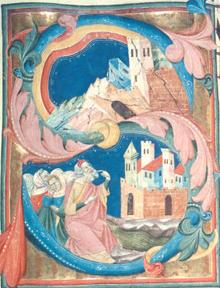 Song
texts for sung masses (antiphonal) decorated for the churches,
convents and monasteries (the initial 'S' to the right is from an antiphonal
from Pisa 1300s now at the Bodleian Library)
Song
texts for sung masses (antiphonal) decorated for the churches,
convents and monasteries (the initial 'S' to the right is from an antiphonal
from Pisa 1300s now at the Bodleian Library) During
the Renaissance, Venice was the center for printing in
Italy and the world, and the types of books that were illuminated widened
to include:
During
the Renaissance, Venice was the center for printing in
Italy and the world, and the types of books that were illuminated widened
to include:
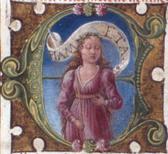 Ariosto's
comedies, and of course Dante's Divine Comedy (1300s Northern
Italy now at the Bodleian Library Hell,
Purgatory,
Heaven)
Ariosto's
comedies, and of course Dante's Divine Comedy (1300s Northern
Italy now at the Bodleian Library Hell,
Purgatory,
Heaven)![]()
Decorative Elements
![]() There
were a limited number of elements possible for the illuminato
to decorate. Each element has a specific name, and some have
different names for each part of an element. There are also
names for every type of decoration! (If you are interested in
all this ephemera, here's a link to an on-line
illumination dictionary from the British Museum.)
There
were a limited number of elements possible for the illuminato
to decorate. Each element has a specific name, and some have
different names for each part of an element. There are also
names for every type of decoration! (If you are interested in
all this ephemera, here's a link to an on-line
illumination dictionary from the British Museum.)
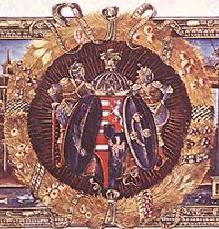 Decorated
initial - small decoration on a starting initial letter
Decorated
initial - small decoration on a starting initial letter
![]()
Marco Polo Book Images
from 1400
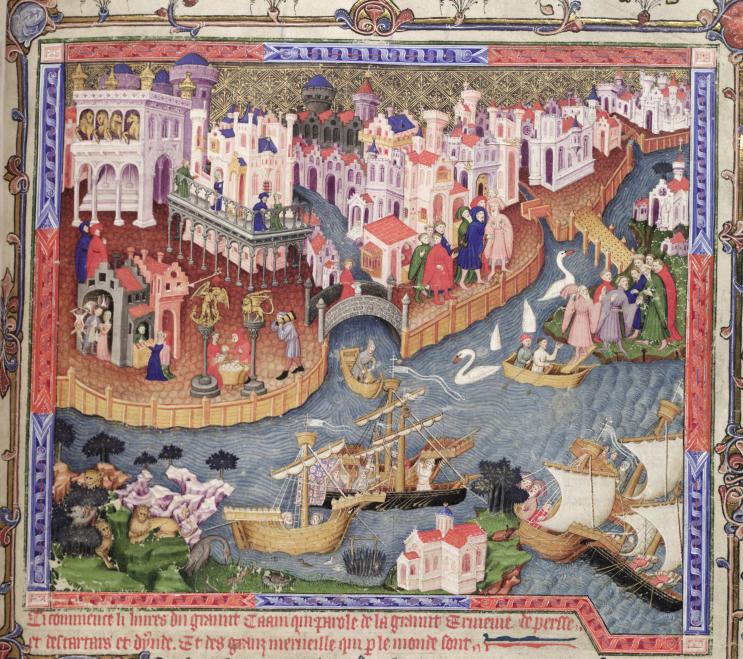
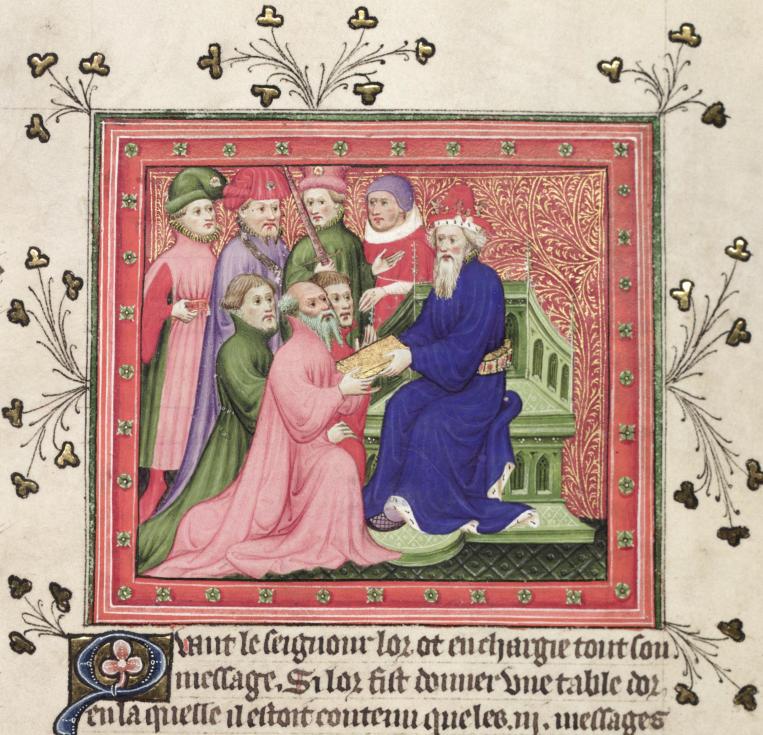
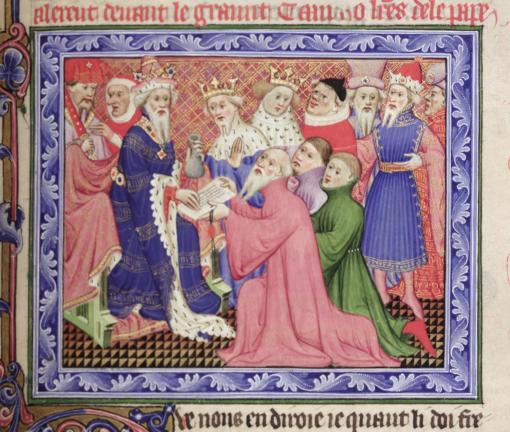
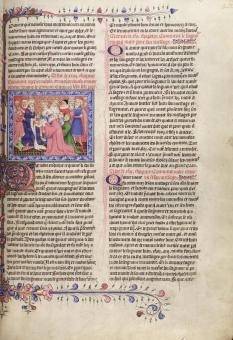
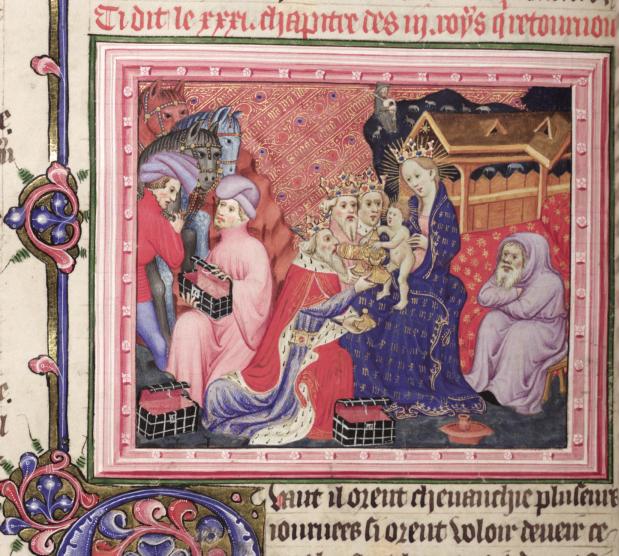

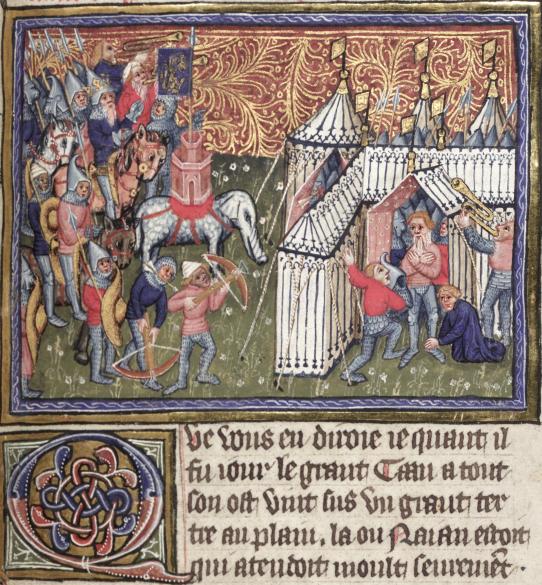

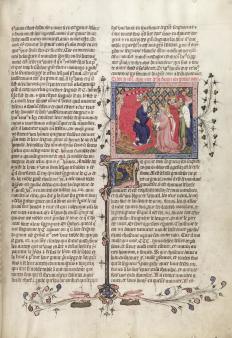
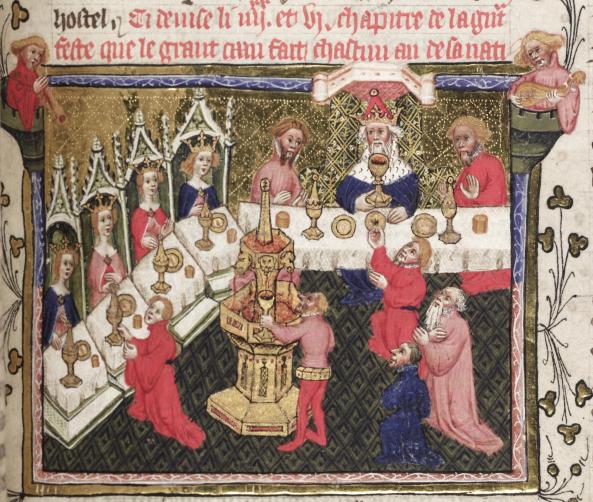


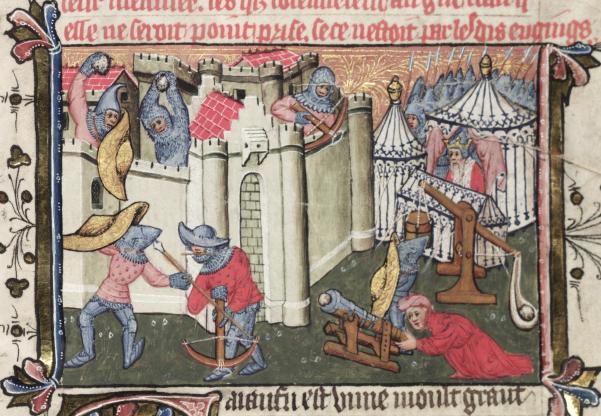
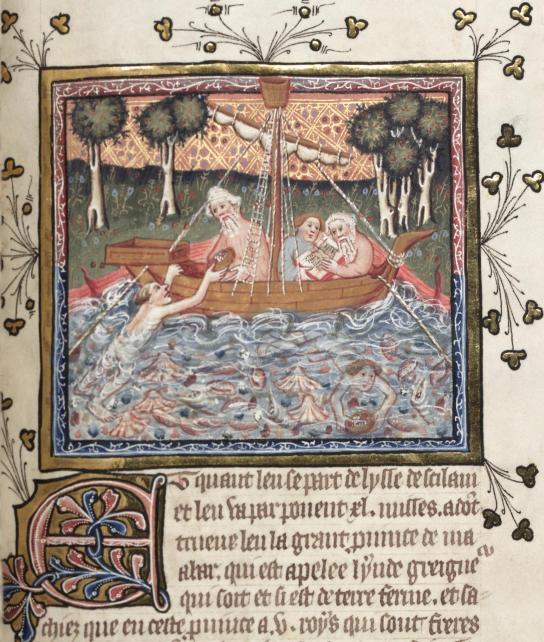
![]()